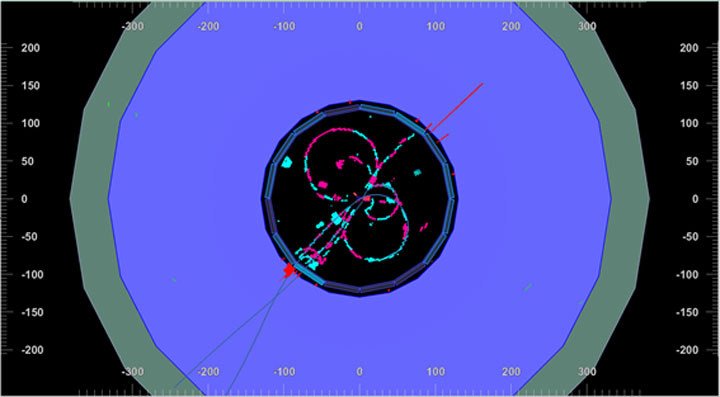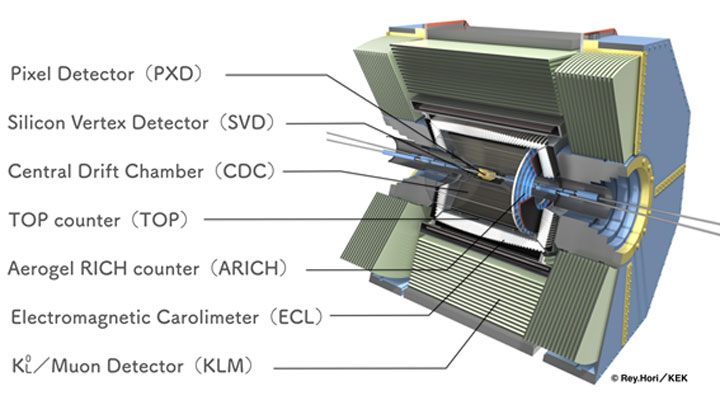Electrons and Positrons Collide for the first time in the SuperKEKB Accelerator
April 26, 2018

A hadronic event in the Belle II detector. Heavier particles produced by the electron-positron collision decay to lighter particles.
The following news release was issued by the High Energy Accelerator Research Organization, known as KEK, in Japan, home of the Belle II experiment. The U.S. Department of Energy’s Brookhaven National Laboratory provides the U.S. portion of the computing and data storage required for the Belle II experiment, taking advantage of the excellent capabilities of the Scientific Data Computing Center as demonstrated with the ATLAS and RHIC experiments. Raw data from Belle II will be transferred to Brookhaven Lab where it will be archived for safe-keeping, calibrated, and processed into a physics-ready data format. From there, scientists at Brookhaven will distribute the physics-ready data worldwide, enabling research by Brookhaven Lab physicists and Belle II collaborators around the world. In addition, Brookhaven Lab's Superconducting Magnet Division built superconducting corrector magnets as part of the SuperKEKB upgrade to enable the improved luminosity. For more information about Brookhaven’s role in this work, contact Karen McNulty Walsh, kmcnulty@bnl.gov, (631) 344-8350.
Electrons and positrons accelerated and stored by the SuperKEKB particle accelerator collided for the first time on 26 April 2018 0:38, GMT+09:00 at KEK in Tsukuba, Japan. The Belle II detector, installed at the collision point, recorded events from electron-positron annihilation (matter-antimatter annihilation) of the beam particles, which produced other particles likely including beauty quark and anti-beauty quark pairs as well as other hadronic and Bhabha scattering events1. These are the first electron-positron collisions at the KEK particle physics laboratory in 8 years; the previous KEKB particle collider ceased its operations in 2010.
The Belle II detector at SuperKEKB was designed and built by an international collaboration of over 750 researchers from 25 countries and regions. Compared to Belle, the detector for the previous experiment, Belle II has dramatically improved capabilities and can detect and reconstruct events at much higher rates provided by the 40 times higher luminosity2 of SuperKEKB. A dataset of about 50 billion B anti-B meson pair production events, which is 50 times larger than the entire data sample of the KEKB/Belle project, will be accumulated in about 10 years of operation.
SuperKEKB, along with the Belle II detector, is a facility designed to search for New Physics beyond the Standard Model by measuring rare decays of elementary particles such as beauty quarks, charm quarks, and tau leptons. Belle II will tackle the problem of finding evidence of the existence of new particles, a new possible reason why matter is dominant compared with antimatter and answer other open fundamental questions in understanding the universe.

Belle II detector with 7 detector subsystems
Last month, KEK began a new stage of operation of the SuperKEKB electron-positron collider, with a brand new positron damping ring, a new extremely complex system of superconducting final focusing magnets, and the Belle II detector in place at the interaction point. A beam of electrons was successfully stored for the first time in the main high energy ring on March 21st. A beam of positrons was also successfully stored in the main low energy ring on March 31st. Since then, final accelerator tuning of the two beams for collisions at the center of Belle II has continued for several weeks.
In contrast to the LHC at CERN in Geneva, Switzerland, which is the world’s highest energy proton accelerator, SuperKEKB/Belle II is designed to have the world’s highest luminosity. SuperKEKB is the leading accelerator on the “luminosity frontier”. Background information on the science goals of the SuperKEKB/Belle II facility is available on the Belle II public web page: belle2.jp
Comments from Project Members and the KEK Directorate
Dr. Masanori Yamauchi (Director General of KEK)
“It is my great pleasure to announce the first collisions in the SuperKEKB accelerator and to celebrate the start of the Belle II Experiment after more than 7 years of major improvements. I am looking forward to seeing how the results from the Belle II Experiment help humankind understand the nature of the universe. We are grateful to everyone who has supported the project so far. Though there will be further difficulties that we must face before the SuperKEKB accelerator achieves its design luminosity, 40 times higher than KEKB’s world record, KEK will strive towards success in research together with many collaborators from all over the world.”
Prof. Tom Browder (University of Hawaii, Belle II Spokesperson)
“After more than seven years of construction and preparation by many dedicated and talented researchers, engineers and students, the Belle II experiment has finally started. This is a truly gratifying moment for all of us in the international collaboration. We now look forward to launching the physics program of the first electron-positron super B Factory. The world is waiting for our results.”
Dr. Carlos Marinas (University of Bonn, Belle II Deputy Run Coordinator and Pixel Detector Commissioning Leader)
“Detecting the first collisions is a great accomplishment of the teams involved in the beam commissioning process over the last months. The deep experience of the Japanese accelerator physicists has brought this far in a very short time and gave us confidence to gradually power up the Belle II detector without any significant risk to the experiment. Now it’s over to the detector physicists to make the best out of the discovery potential this superb machine is giving us; we are ready to accept the challenge.”
Assistant Prof. Tomoyuki Konno (Kitasato University, Belle II DAQ Group)
“We have been working hard to upgrade the data acquisition system, consisting of thousands of electronics boards and computers, to handle a maximum trigger rate of 30 kilo-Hertz. Our centralized control system, which supervises all the electronics systems such as power supplies for sub-detectors, trigger timing distributions, readout electronics inside the detector and the high level trigger computing farm has been developed, commissioned and is now fully operational and ready to record the first collision data. We are happy to start data taking on time with beam collisions.”
Press Contacts in Japan
Hikino Hajime, KEK PR Office, press@kek.jp
Prof. Toru Iijima, Belle II Outreach coordinator, Nagoya University, iijima@hepl.phys.nagoya-u.ac.jp
Footnote
- Bhabha scattering event; The electron-positron scattering process, which is named after the Indian physicist Homi J. Bhabha.
hadronic events; Hadron production processes caused by the collision of electrons and positrons. A hadron is a composite particle made of quarks held together by the strong force. Hadrons are categorized into two families: baryons, made of three quarks, and mesons, made of one quark and one antiquark. Pair production of a B meson and an anti-B meson is an example of a hadronic event. - Luminosity is a measure of the rate or intensity of electron-positron collisions.
Additional images are available at the KEK webpage: KEK Image archive (https://www.kek.jp/ja/imagearchive/)
2018-12859 | INT/EXT | Newsroom









